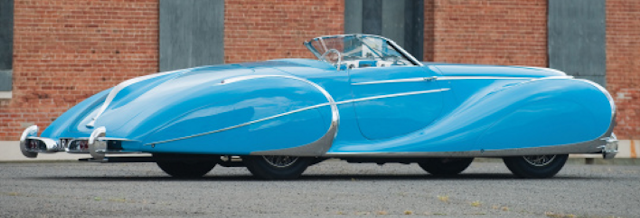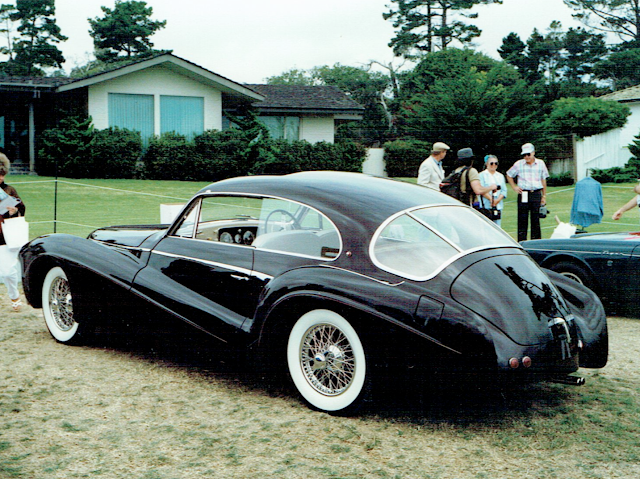Prior to leaving their namesake firm to found OSCA*in 1947, the Maserati brothers finished their design for the A6 1500, a car project they'd started before the war. Most of the bodies built for just over 5 dozen of these first A6 models built were by Pinin Farina, but there was at least one Panoramica designed and built by Zagato* in the late Forties, in a form that set the themes for their trademark postwar style. Curves formed in light alloy showed a concern for aerodynamics, and they were carried into the greenhouse, with windows curved in section. The low window sills and tall glazing were predictive of much later cars. The integration of roof forms with the lower body was much smoother than on the Pinin Farina models.

The front view emphasizes the low sills and tall greenhouse. Instead of a compound curved windshield, Zagato chose a 4-piece solution with flat glass. A compound curve would have been better for visibility, but more difficult to form. The last of these 1.5 liter, single overhead cam six cylinder cars was built in 1950.
In 1949 Zagato released a lone Ferrari 166 Panoramica in the same style as the Maserati, including the curved plexiglas side windows and the artfully recessed bright metal side trim. The few differentiating features included a simpler two-piece windshield with a lower header, and the oval eggcrate Ferrari grille that would soon be nearly a standard feature. The 2 liter V12 also rode on a shorter wheelbase than the 1.5 liter Maserati six, as evidenced by the rear wheel intrusion into the door space shown in the rear view. This one-off design, chassis #0018M, was raced by driver Stagnoli, shown with the car in the rear view.
Zagato did not body any of the successor, 2 liter single-cam A6 Maseratis, but after building only 16 of those, Maserati moved on to the A6G2000, with twin overhead cams underlining sporting intent. This series was also called the A6G54, for the year of its introduction. Zagato bodied 20 berlinettas in aluminum; 19 of these were in the fastback style shown below. Note that the silver car below, an early example, has a continuous fender line from front to rear, and no hood scoops...
A later version has haunches formed into the rear fenders, and shares side glass subtly curved in section with the silver car. The front view shows off the twin hood scoops, and a different grille shape...
The interior manages to look purposeful without seeming stark. Most knobs and switches are not labeled, a common omission on Italian cars of this era. Fortunately, for the $10,000 asking price in 1955, you got an owner's manual. No glove compartment, though...
The rear shows off Zagato's mastery of simple shapes and harmonious contours. This series of just over twenty cars, a big order for Zagato in the 1950s, did not lead the firm to any more series production orders from Maserati for nearly 3 decades. The Orsi family, which controlled Maserati, had decided to make a real production car of their planned 3500GT, and would call on the larger facilities at Touring Superleggera and Vignale to build the bodies.
Zagato built only one open car on this chassis; the spider was released in 1955, but has the earliest chassis number (2101) in the Zagato A6G2000 series. Note the different hood scoop and side vents in the fenders, and the more substantial bumpers.
The spider uses the same hunched rear fender forms as the later coupes, but with a more complicated treatment of the tail lights, which are set above the arc of alloy that descends to the rear bumpers. After its early life on the show circuit and in weekend road rallies, the car was purchased by a member of the American military in Europe, and he used it as a daily driver. It seems a shame there was only one of these...
There was only one Berlinetta Speciale as well, in 1956. This was a notchback coupe, and apparently the first Maserati to feature Zagato's trademark twin-hump roof, which had already appeared on some Fiat 8Vs. Note the curved side windows, the lower, smaller grille opening, and the hooded headlights.
This wasn't the end of the trail for Zagato Maseratis, and we're not referring to the BiTurbo Spyders made from 1984-94. Those were production cars, with over 3,000 made. The last Zagato-bodied Maserati to capture the attention of road racers was designed for the 1957 Le Mans by British aerodynamicist Frank Costin, and built by Zagato on the 450S chassis. Costin had already designed the Lotus Eleven and would soon become famous for his work with Peter Kirwan Taylor on the Lotus Elite coupe.
Details like the 4-piece windshield reflect the haste with which the body was fabricated in order to be ready for the 24-hour race. It recalls the faceted windshield on Zagato's first Maserati, from a decade earlier. There were other details, like cockpit ventilation, that were left unfinished, and Stirling Moss and Harry Schell managed 32 laps with the powerful 4-cam V8 before the rear axle gave up...
After its racing career was finished, the lone 450s coupe, unique among the ten 450S cars built, was adapted by Zagato for road use, and finally given a curved, one-piece panoramic windshield as well as side windows behind the doors. The front view shows off Costin's concern for minimal air resistance and low overall height. The rear is evidence of Zagato's skill at forming aluminum into smooth, compound curves.
Meanwhile, in 1956 Ferrari was planning to get into series production with their 250GT, but other than prototypes of the notchback Pinin Farina coupe design built by Boano, most of the 250GT cars that year, like the Scaglietti-built PF Tour de France berlinettas, featured special bodies with individual variations. None of these was more special than the Zagato design commissioned by Camillo Luglio that year on chassis #0515GT...
The low stance, tight contours, curved side glass and "double bubble" roofline reflect the coachbuilder's interest in reducing wind resistance. As this car, like many Zagato designs, was intended for racing, efforts were made to reduce weight below that of the PF / Scaglietti cars.
The form of the rear was predictive of Sixties designs, with a concave, recessed tail panel linking the tail lights, with an arrow-shaped "C" pillar that later appeared on other Zagato designs. The way the convex deck housing for the license plate echoes the concavity in the roof is a deft detail, linking the deck and roof forms visually. The competition success of this first car led the owner to order a second, lighter car to race. This car had a smaller hood scoop, and larger front fender vents...
At the rear, the roof forms were the same, but the deck lid was simplified, without the raised center surface, and with a deeper opening for the trunk...
The competition success of this second car ultimately led to a total of 5 long-wheelbase Ferrari 250GT coupes being commissioned from Zagato. There were no two cars alike. On the last car, shown below, the roof form has been simplified to a single curve in section, without the trademark bubbles. There are, however, transparent bubbles covering the headlights. Bumpers, front and rear, have been reduced to horizontal nerf bars...
At the rear, the "C" pillar is a simple angled support instead of the arrow shape on the earlier cars. This chassis, #1367GT, was not the last Ferrari to be bodied by Zagato, but it was the last to be built during the coachbuilder's golden era of undecorated, perfectly-proportioned contours. The arrival of the wedge craze in the 1970s would bring new commissions and challenges, but that's a story for another day.
*Footnote:
OSCAs are featured in "The Etceterini Files Part 7: Almost Famous", from April 20, 2016. Abarth Zagatos are pictured in "The Etceterini Files Part 13" from Jan. 15, 2018. Other cars bodied by Zagato are detailed in "Roadside Attraction: Swiss Museum of Transport" from July 4, 2019, and in "Lime Rock Concours" from Sept. 17, 2019.
Top & 2nd from top: wikimedia
3rd & 4th: en.wheelsage.org
3rd & 4th: en.wheelsage.org
5th thru 7th: the author
8th thru 10th: Lt. Jonathan Asbury, USN
11th & 12th: youtube.com
13th thru 15th: Carrozzeria Zagato
13th thru 15th: Carrozzeria Zagato
16th: pinterest.ca
17th: gramho.com
17th: gramho.com
18th: the author
19th: George Havelka
19th: George Havelka
20th & bottom: Carrozzeria Zagato










































































